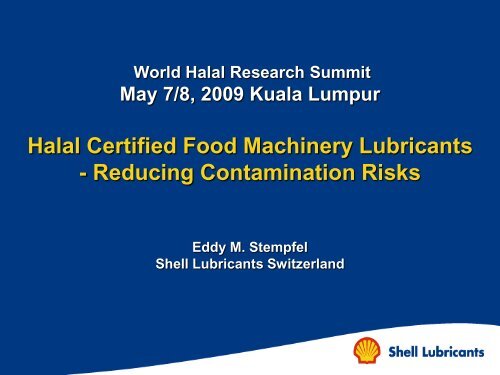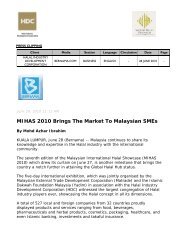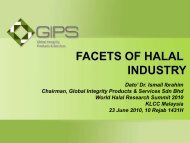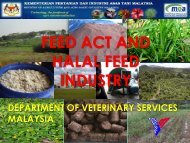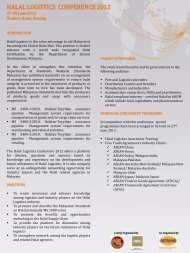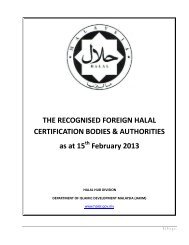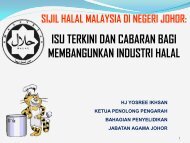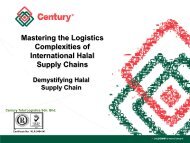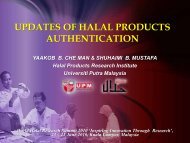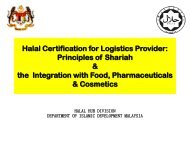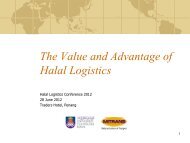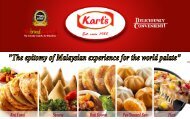Halal Certified Machine Lubricants - World Halal Week
Halal Certified Machine Lubricants - World Halal Week
Halal Certified Machine Lubricants - World Halal Week
You also want an ePaper? Increase the reach of your titles
YUMPU automatically turns print PDFs into web optimized ePapers that Google loves.
<strong>World</strong> <strong>Halal</strong> Research SummitMay 7/8, 2009 Kuala Lumpur<strong>Halal</strong> <strong>Certified</strong> Food <strong>Machine</strong>ry <strong>Lubricants</strong>- Reducing Contamination RisksEddy M. StempfelShell <strong>Lubricants</strong> Switzerland
Content Introduction Market Information (Foodstuff and <strong>Lubricants</strong>) Food Crisis – Do you like <strong>Lubricants</strong> on your plate or in your glass? Food Manufacturers – the Danger of Brand- and Collateral Damages Requirements for Food Grade <strong>Lubricants</strong> General Remarks (Requirements of OEM‟s and Customers, Monitoringof <strong>Machine</strong>ry and <strong>Lubricants</strong> during use How do I ensure proper and optimal Lubrication (Switch Over Process,Storage of <strong>Lubricants</strong>, Handling, Lubrication Charts) ? Performance of Food Grade <strong>Lubricants</strong> Application Examples (Gears, Hydraulics, Can Closers/Seamers,Compressors and Vacuum Pumps, Conveyors, Citrus Presses, AnimalFeed Manufacturing, Heat Transfer Systems Summary / Conclusion
IntroductionThe food industry and raw materials suppliers from thepharmaceutical and chemical industries are puttingmore and more pressure on lubricant manufacturers todevelop and recommend special lubricants for theprocessing of foodstuffs: New and more demanding Legislation Higher hygiene standards, such as the HACCP(HazardAnalysis and Critical Control Points) … and not to forget: the basic function of <strong>Lubricants</strong>
Introduction<strong>Machine</strong>ry and equipment in the food industry do inprinciple not differ from those used in other industries, butthe environmental influences acting upon them may beconsiderably more complex: Daily Cleaning of <strong>Machine</strong>ry, sometimes with:High Pressure water washing & aggressive cleaning/sanitizingfluids. Contamination with active substances (Fruit Juices & Sugar) Impact of extreme Temperatures, from Shock Freezing toWafer Ovens (extremely low to very high in short time periods)
IntroductionSpecialist knowledge and practical experience are veryimportant to allow the best possible lubricant to berecommended and the maintenance intervals for lubrication tobe specified, the latter being tailored to the particularapplication and the environmental conditions.Oil change intervals depend more on contamination of thelubricant than on the reduction of its lubrication properties dueto the degradation of additives, or the oxidation of thelubricant.An exciting challenge which will have to be met with a rangeof high-performance lubricants and with specialist knowledge.User input is essential here.
Market InsightQuality, hygiene and product liability are exceptionallyimportant matters in the food, drink and pharmaceuticalindustries. Large sums are invested to give a brand a highprofile in the consumer goods sector, but a good reputationcan be quickly ruined by the negative publicity generated bya product recall and this often has drastic financialconsequences.According to most regional legislation, a food manufacturerremains liable unless he can demonstrate that he has takenevery conceivable step to prevent food contamination. TheGovernment will monitor all food manufacturers to ensurethey comply with regional and international statutoryregulations
Market InsightThe local authorities are also have a joint responsibility for thesafety of any food finding its way onto the market. New regulationsin the body of laws known as the Food Hygiene Regulations ofthe Consumer Goods Act have been in force since 31 December1995. One major aspect of these regulations, which were derivedfrom Regulation No 852/2004 (formerly directive 93/43/EEC), isthe introduction of the HACCP concept (Hazard Analysis andCritical Control Points), which is based on the US model.The EU, in common with the US, uses the HACCP concept inorder to allow critical points in the preparation, packaging anddistribution process chain to be identified and controlled.
Market InsightAnother important European basis is Directive 89/392/EEC of 14June 1989: the EHEDG (European Hygienic Equipment DesignGroup) Regulation on the Design of <strong>Machine</strong>ry for FoodProcessing Purposes.
Market InsightAs there is no international standard for food-compatible lubricants, it isnormal practice to use the US standards issued by: FDA (US Food and Drug Administration) and USDA (US Department of Agriculture).The USDA ceased registration of lubricants in 1998, and this functionwas taken over by the private institution NSF International (previouslyknown as the National Sanitation Foundation
Market InsightThe food market is one of the most innovative markets, and continues toface very strong competition. Quality and productivity are thereforeexceptionally important . Some Figures: yearly Growth in Europe: 5% (2-6% from region to region) the third largest industry in the European Union employing some 2.7 million people in over 26,000 companies oil products demand: about 1.17 million metric Tons whereof about 15„000 metric tons (33 million pounds) <strong>Lubricants</strong>.The proportion of food grade lubricants varies between 5% and 20% fromone country to another.Germany with biggest market share generates about 152 billions Euro (200 billions US$) applies about 1.33 billions Euro for Energy (1.77 billions US$).Other important markets in Europe are Italy, UK, France, Spain and theNetherlands.
Market InsightTypical Sub-Sector SplitFood production, m ajor sectors in the U KM E A T P R O C E S S IN G14%O T H E R FO O D10%A N IM A L FA R M3%P U LP P A P E R2%A N IM A L FO O D6%FR U IT & V E G7%D R IN K10%D A IR Y & FA T S6%C O N FE C T IO N E R Y6%B R E A D &B IS C U IT & C E R E A LS36%Main sectors in food production
Food Crisis – Do you like <strong>Lubricants</strong> on your plate or inyour glass?Almost every day we are faced with crisis situations relatingto foodstuffs.An apt example is the need to recall products contaminatedby glass, metal particles, or toxic substances harmful tohumans, which in turn damages the manufacturer’s imageand brand name. A number of such crises in the food industrycan be found on websites like:www.recalls.gov.au/www.ukrecallnotice.co.uk/
Food Crisis – Do you like <strong>Lubricants</strong> on your plate orin your glass?Example1:Food and animal feed contaminated by PCB(Polychlorinated Biphenyl) because during the productionprocess PCB escaped from or was given off by defectiveheating elements. In 1968 some 1300 people fell ill inFukuoka, Nagasaki and other areas of Western Japanbecause they had consumed rice bran oil contaminated with2000 to 3000 parts per million (ppm) of a substance ofJapanese manufacture used in a heated transport systemthat contained PCB.
Food Crisis – Do you like <strong>Lubricants</strong> on your plate or inyour glass?Example 2:The Belgian dioxin crisis broke out in1999, when it was discovered that thiscarcinogenic substance had got into thefood chain as a result of thecontamination of animal feed. The newsthat a food presented a health riskreverberated around the world, and led toimport bans on food and livestock fromBelgium. This crisis, which was triggeredby the contamination of food with dioxin,directly cost the Belgian Government €632.1 million (25.5 billion BelgianFrancs, according to a Governmentstatement).
Lubricant Contamination Throughout the <strong>World</strong>Date Company Name Product Problem Quantity Location2005 Empak Foods Beef contanimated food - hydraulic oil 123,000 lbs. Wisconsin2002 NQR Soft Drink contanimated food - lubricant 4,000 cases Australia2002 Arinco Milk Powder contanimated food - lubricant2002 Mishima Shokuhin Seasoning contanimated food - lubricant2002 Medpoint Healthcare2001 Kraft FoodsCarispordoltabletsMicrowavemacaronicontanimated food - lubricantcontanimated food - compressed air system lubricant1,100 tons ofproduct55 tons ofproducttraced back to1983142,000casesDenmarkJapanNew JerseyIllinois2000 Farmland Foods Turkey Meat contanimated food - non food grade lubricant 86,000 lbs. Missouri2000 Heinz Baby Food contanimated food - lubricant U.K.1998 Smithfield Packing Ham contanimated food - gear lubricant 490,000 lbs. North Carolina
Food CrisisEU to restrict Ukrainian sunflower oil after contamination scare(BRUSSELS 24 May 2008) - The European Commission blocked Fridayimports of Ukrainian sunflower oil into the EU until Kiev puts a strict system ofchecks place, after tainted product was found in the bloc last month."Sunflower oil originating in, or consigned from, Ukraine shall not enter theEU unless a valid certificate and results of sampling and analysis for thepresence of mineral oil accompany the sunflower oil consignments,“ it said.UK Food Standards AgencyThe Agency wrote to organisations representing suppliers and importersof cooking oils in May 2008 to alert them to the presence in the UK ofsunflower oil containing mineral oil. The oil originated in Ukraine. Sincethen the European Commission has imposed a temporary ban on allimports of sunflower oil from Ukraine.Total sunflower-seed oil export from Ukraine to the EU is worth $1 billion a year. Thecontaminated oil was discovered in 13 European countries (Belgium, Germany, Spain,France, the Great Britain, Greece, Ireland, Italy, the Netherlands, Norway, Portugal,Romania, and Sweden) and nine other states (Albania, Azerbaijan, Ghana, Monaco,Maldives, Turkey, Taiwan, Tanzania and Vanuatu).And these are just the cases that hit the public media
Food Manufacturers and the Fear of Loss ofImage or Collateral Damage“Sliced Turkey Products Contamination With Oil”Food manufacturer in Kansas City recalls 40,000 kg of sliced turkey, which maybe contaminated with (non-food grade) lubricants.“USDA Food Safety & Inspection Service recalls products”Smoked ham. Various kinds of smoked ham, including sliced, diced and honeyglazedham, produced under various brands, may be contaminated withtransmission oil.“USDA Food Safety & Inspection Service recalls products”Sliced and packaged turkey products contaminated with non-food compatiblelubricant.“Oil in baby food”A random inspection showed that a can of baby food was contaminated with aharmful lubricant.Note concerning the three product recalls in the US: “only” 0.5% of themeat recalled was actually contaminated, but 250,000 kg were recalled.
Food Manufacturers and the Fear of Loss ofImage or Collateral DamageRather sadly, in addition to increased statutory requirementsit is such fears that in recent years have provided the majorimpetus to food manufacturers to invest a great deal ofmoney and energy in developing safer procedures. Thisis not surprising when one considers what can happenwhen a well-known company suddenly finds itself gettingnegative headlines in the media.A glance at the so-called market value of a global brand issufficient to obtain a better understanding of this .
Food Manufacturers and the Fear of Loss ofImage or Collateral DamageBrand/Sector(2007 Brand value ex: Interbrand, Citigroup, Business <strong>Week</strong> Aug 6, 2007)Market Value in US$ billionsSoft Drinks 65.3Computer Software 58.7Computer Software &Hardware57.1Computer Hardware 30.9Entertainment 29.2Car Manufacturing 23.6Coffee 12.9Soft Drinks 12.9Beer 11.7Cereals 9.3Tomato Products 6.5Chewing Gum 5.8Baby Food 5.3Dairy 5.0
Food Manufacturers and the Fear of Loss ofImage or Collateral DamageThe first example we could mention here would be a car manufacturer/ tyre manufacturer case. Even though this did not involve foodcompanies, the outcome is an example for all branches of industry.For example, it led to the following results: 91% reduction in profits in the six months following the event,compared with the previous year Change in market value: from US$ 36.4 billion to US$ 20.4 billionwithin two years Recall costs for 50,000 vehicles: US$ 3 billion Legal costs: US$ 840 million 11% rise in the number of customers who will no longer buy such avehicle.These figures are very interesting, especially as the whole fiascoinvolved not just the car manufacturer, but a supplier as well
Food Manufacturers and the Fear of Loss ofImage or Collateral DamageThe second example sets out the facts of a case of contamination inJapan. Contaminated milk led to the following results there: Loss of 53 and 72 billion Yen respectively in the years 2000and 2001 Workforce reduced from 5500 to 4000 (27%) in the first year Workforce reduced by a further 1500 in 2003.The third example describes the situation of a soft drink manufacturer.Contamination of soft drinks in Belgium led to: Recall costs (Belgium): US$ 103 million 5% drop in sales 20% drop in share value.In this case it is interesting to note the evidence that the main competitorwas also harmed by this incident.
Food Manufacturers and the Fear of Loss ofImage or Collateral DamageBehaviour of share prices of two competitive soft drinkmanufacturers
Food Crisis – <strong>Lubricants</strong> – What can be done?Lubrication ChartsLubricantManufacturers oftenoffer so calledLubrication Chartsto their customers,sometimes inconjunction with anLCCP-Survey(Lubrication CriticalControl Point) as asupport to increasefood safety.Often a Flow Chartshowing criticalareas of productionis used as a startingpoint.Flow Chart Brewing
Customer Approach / PhilosophyBasically Customers fall into two categories: Use of H1 <strong>Lubricants</strong> in CCP‟s (CriticalControlPoint) only Use of H1 lubricants in the whole plant
Customer Approach / PhilosophyBy using H1 <strong>Lubricants</strong> in CCP„s only, there is a basicrule, which can be applied *):The alignment of CCP’s is basically in almost everycase above or lateral to the food flow.Lubrication Points below the food flow can, as long asthey are not pressurized, be lubricated withconventional lubricants.*) Keep in mind by choosing this approach: Non H1 <strong>Lubricants</strong> can be “transferred” from non sensitive tosensitive areas by shoes. There is a danger of mix-up of H1 with non H1 lubricants in thelubes store.
Food Crisis – <strong>Lubricants</strong> – What can be done?Storage and HandlingStorage: Bad ExampleStorage: Good Example. Colour coded byApplication. Food grade lubricants separatedfrom ordinary lubricants.
Food Crisis – <strong>Lubricants</strong> – What can be done?Storage and HandlingHandling, Best Practice. All should beLabelled clearly.Sample Taking for Oil Analysis
Food Crisis – <strong>Lubricants</strong> – What can be done?MaintenancePotential danger due to over-lubrication..Poor Maintenance. Excess of grease can betransferred to sensitive areas of themachine:Open food containers pass pretty near.Potential Leakage? Where is the Oil?Open bottles passing directly below. Is itin the food product. To be safe foodgrade lubricants should be used.
Food Crisis – <strong>Lubricants</strong> – What can be done?MaintenanceNo Comment....Potential Leakage? PoorMaintenance. Where is the Oil? Is iton the food product?
Food Crisis – <strong>Lubricants</strong> – What can be done?Compressors and Vacuum Pumps
Food Crisis – <strong>Lubricants</strong> – What can be done?GearsLeaking Gearbox above production lineshould be filled with food grade lubricantsand should be monitored closely bymaintenance departmentLeaking Gearbox above production lineshould be filled with food grade lubricantsand reason for leakage should beinvestigated and action taken.
Requirements for Food Grade <strong>Lubricants</strong> General Requirements Industry Specifications (Performance) Equipment Manufacturers (OEM„s) Manufacturers of Final Equipment Manufacturers of Components Monitoring <strong>Machine</strong>ry and <strong>Lubricants</strong>
Requirements for Food Grade <strong>Lubricants</strong>In this case the requirements for lubricants are not governed exclusivelyby technical considerations. It must also be borne in mind that <strong>Machine</strong>ry and facilities are developed and built on the basis ofhygieneconsiderations. The lubricant should be regarded as an element in thedesign here, and it is entirely possible that the requirements placed onitmay deviate from the normal industry standard (HACCP, EHEDG, EU,ISO, ASTM/ANSI and local guidelines) The formulation chemist is severely restricted by the limited number ofpermitted additives and base oils available, and as a consequence itmay not always be possible to achieve maximum performance (FDA,USDA, NSF)
Requirements for Food Grade <strong>Lubricants</strong>NSF Listings (http://www.nsf.org/usda/psnclistings.asp )
Requirements for Food Grade <strong>Lubricants</strong> Other bodies and institutions may restrict further theuse of lubricant components (Kosher, <strong>Halal</strong>,associations for gas and water). Finally more and more questions have to be handledregarding GMO’s / Allergens / BSE
A number of lubricant manufacturers have even carried out a CCP (CriticalControlPoints) analysis, and use food grade lubricants to lubricate their own equipment.In addition, at least one manufacturer applies a special so-called GMP (GoodManufacturing Practice) in its certified facilities, which from our point of view istheRequirements for Food Grade <strong>Lubricants</strong> -ManufacturingAccording to the current standard, food grade lubricants are only produced inthoseparts of a production facility (conduits, mixing vessels, bottling plant), which arecertified according to ISO 9001 / 14001 / 21469
Requirements for Food Grade <strong>Lubricants</strong> -ManufacturingAs food-compatible lubricants do not as a rule differfundamentally from standard mineral oil-based products, thesame production facilities can usually be used (liquidlubricantsand greases). However, it is quite clear that during the manufacture offood-compatible lubricants more stringent rules areapplied in order to achieve the greatest possible purityand avoid cross-contamination. According to the current standard, food grade lubricantsare only produced in those parts of a production facility(conduits, mixing vessels, bottling plant), which arecertified according to ISO 9001 / 14001 / 21469
ISO 21469 Certification – the most actual challenge fora <strong>Lubricants</strong> ManufacturerISO 21469 <strong>Certified</strong>
ISO 21469 Certification – A New Certification Programfor Food Grade <strong>Lubricants</strong>NSF Certification Programs are accredited by the American NationalStandards Institute (ANSI)As an ANSI accredited Certification body, NSF develops AmericanNational Standards and certifies products to internationally acceptedstandards. NSF Certification gives the confidence of knowing that ourproducts and processes are in compliance with internationally acceptedfood safety standards.It is a key component in any HACCP-based risk management programinspectors and users, registered products are listed online in the NSFWhite BookTM at www.nsfwhitebook.org.Label change:ISO 21469 <strong>Certified</strong>
Product Certification vs Product Registration only –the Safety Benefits for the UserCertification © / Registration ® consist of: Formulation Review © ® Product Label Review © ® Risk Assessment © Facility Audit: © Raw material verification Batch sheets agree with the NSF authorized formula <strong>Certified</strong> product labelling complies with the NSF Markingrequirements Verify QC practices / procedures resulting from the riskassessment GMP / GHP practices ISO 9001 Registration Product Testing ©
Performance of Food Grade <strong>Lubricants</strong>By speaking with Customers in the Food Industry one oftenencounters: H1 lubricants are in general worse than standard lubricants Lifetime and Wear Protection is a problem Application is difficult and problematic etc. etc.This may have been the case 20 years ago. Today, modern H1lubricants are well designed and balanced high performanceproducts.As a Summary:„Food Grade <strong>Lubricants</strong> are not “exotic components”.The Selection and Application follow the same rules asfor standard lubricants”.
Food Grade Hydraulic Oils, ComparisonSyntheticH1White OilH1Standard mineraloil - non FoodGradeMultigrade Characteristics Antiwear Characteristics. Oxidation Stability Filterability Corrosion Prevention Foam Characteristics Seal Compatibility NBR-1 Low Temp. Characteristics Overall lifetime in the field Overall / Key: =Excellent, =Good, =Fair
Food Grade Greases, ComparisonSyntheticH1White OilH1Standard mineraloil – non FoodGradeAntiwear Characteristics Oxidation Stability Mech. Stability Water Resistance Corrosion Prevention Seal Compatibility NBR-1 Low Temp. Characteristics Overall Key: =Excellent, =Good, =Fair
Performance of Food Grade <strong>Lubricants</strong>This point continues to be the subject of discussions,especially between users or OEM’s and lubricantmanufacturers. Depending on geographic location, theprevailing opinion is that lubricants for the food industry donot come up to the performance levels of standardlubricants, that more problems of wear and tear occur andthat, generally speaking the lifetime of an oil filling isreducedThe synthetic lubricants in particular now achieveperformance profiles at least as high as those ofconventional synthetic lubricants, if not higher.
In general synthetic lubricants perform betterBy using “Synthetics” a user usually gets: “Cleaner” and Safer products Superior performance Extended lubricant life Rationalised portfolio Less lubricants used Reduced downtime Minimised waste/disposal Extended <strong>Machine</strong>ry LifeAll this will result in lower overall maintenance costsand improved food safety
Storage and HandlingBeside the given examples there are quite a number of otherprecautions / measures, which are related to ensure clean, safeand proper lubrication: Re-Lubrication Intervals Lubrication Volumes Control of Oil Level (how often) Top Up Volumes Sample Taking for Oil Analysis (how often) Check for Leaks Control of Filter Equipment Control of Central Lubrication Systems Check of Reservoir Vents Etc.
Switch Over ProceduresGrease Compatibility
Switch Over ProceduresKeeping in mind the FDA / USDA Limits it is crucial to follow a properSwitch Over Process to ensure that as less conventional lubricant aspossible remains in the system. It is recommended to switch overmachinery during a scheduled maintenance break.Example for Oils (General Rough Rule): Drain the used oil from the warm system (normally about 5-10% ofoldoil remain in the system, including wear particles and oxidation /hydrolysis by products) Clean the system as good as possible (especially hydraulicreservoirsand central lubricating systems) Fill the system with new lubricant. Use a cheap flushing fluid the firsttime (e.g. technical white oil) Run the system for a short period under light load only Repeat the whole process until the visual aspect of the new drainedoil becomes identical to the new fluid.
Switch Over ProceduresExample for Greases (General Rough Rule):Procedure 1 (best way): Dismantle everything completely. Clean parts as good aspossibleand re-mount them again. Lubricate with new Grease before orafter re-mounting.Procedure 2 (easiest way): „Push Through“ new grease as long as the old grease hasdisappeared from the bearings. Take care to not over-lubricatebecause this may lead to excessive heat and finally bearingfailure.Both Procedures: Increase the re-lubrication intervals for a certain period of time.
MoreApplication Examples
Application ExamplesGearsLeaking Gearbox above production lineTypical CCP. Gearbox above productionline
Application ExamplesGearsTypical CCPGearbox and electric motor aboveproduction lineTypical CCP (Mixing Kettle)Leaking Oil may follow the shaft directly into themixing kettle
Application ExamplesHydraulics„Hidden“ CCP.High-Pressure Hosesbeside production line
Application ExamplesCan SeamersTypical CCP.Can Seamer. Grease directly above cans. Due tothe relatively high speed, grease may fling off andcontaminate cans.Can Seamer, Lubrication System.Older models using loss lubrication may takeup to 2 gallons of lubricant a day.
Application ExamplesCan SeamersCan Seamer.Typical Leakage by poormaintenance (seals).Leakage made visible bydyed lubricant.Picture taken after 75minutes from starting upthe machine.
Application ExamplesTransport- and Conveyor SystemsBakery, Trolleys. Extension of re-lubrication intervals by using an synthetic H1 grease
Application ExamplesTransport- and Conveyor SystemsCCP: Conveyor in BakeryConveyor in Abattoir. Typical CCP:Lubrication Points above productionline
Application ExamplesCitrus-Processing<strong>Machine</strong> Inside. Lubrication of Shafts andBearings. In this case “standard” Gear Oilsmay run into problems because of heavycontamination with water and juiceTypical Citrus Press
Application ExamplesAnimal Feed - ManufacturingPellet Press – Animal Feed ProcessingBearing of a Pellet Press
Application ExamplesHeat Transfer SystemsHeat Transfer System(Potato-Chips) with „Micro-Leakage“.
Application ExamplesMaintenanceCCP: Oil- and Grease just beside foodcontainers.Typical CCP (Grease). Shaft and Bearingdirectly above production line.
Application ExamplesCompressors and Vacuum PumpsTypical CCP.Compressed Air blowndirectly on the foodstuff
Performance of Food Grade <strong>Lubricants</strong> / ConclusionToday‟s H1 lubricants areHigh Performance <strong>Lubricants</strong>, based on selectedtechnical / pharmaceutical / medicinal Mineral White Oilsor Synthetic Base Fluids.This and the fact that the manufacturer is allowed to usedesignated FDA chemicals only and that the productsshould be manufactured in dedicated parts of his plant isresulting in higher R&D and manufacturing costs, whichfinally leads to more expensive products.Especially by using synthetic products the higher price isoften compensated by a longer lifetime of the productand lower overall maintenance costs.
Conclusion / SummaryThe general rule is:“<strong>Lubricants</strong> (oils and greases) must not have any adverseeffects on foodstuffs.”This means that lubricants, which may accidentally come into contact withproducts intended for consumption as a result of leaks, which are notalways technically avoidable, or unsuitable design of equipment ormachinery, must satisfy the most stringent of the requirements listedabove.Regarding Application: The Application of Food Grade <strong>Lubricants</strong> does not differ fromotherIndustry areas. There are more stringent requirements regarding Hygiene andContamination. Supporting Customers by lubrication specialists regardingLCCP‟s
Many Thanks for Your Attention“Now, Please Relax and Do NotForget-- Food Is Good! –as long as food grade lubricantsare used for its processing….”


